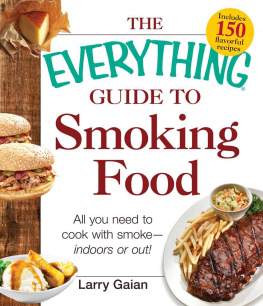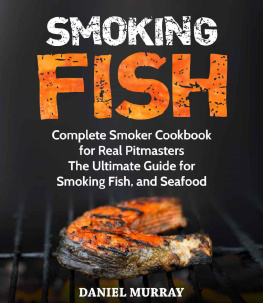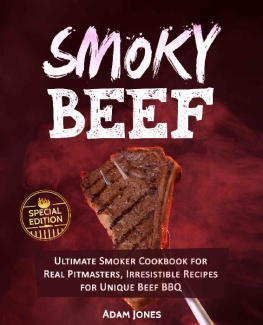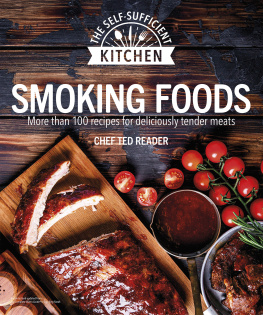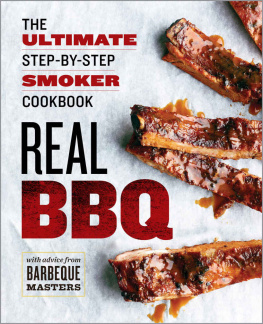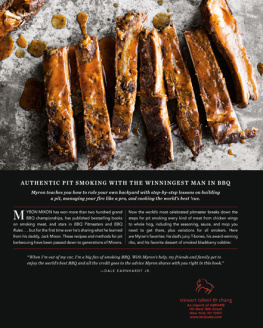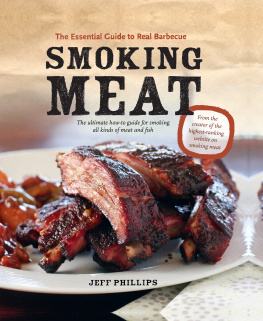THE

GUIDE TO
SMOKING FOOD
All you need to cook with smokeindoors or out!
Larry Gaian

Avon, Massachusetts
This book is dedicated to my wife, Celeste. Her love, support, and inspiration have made everything I do possible.
Contents
Introduction
While this book does contain grilling techniques and tips, this isnt a book solely about barbecuing and grilling. Its about one of the oldest cooking processes on earthsmoking.
For years now, people all over the world have been using the flavors of smoke to enhance meals. Today smoke is still used as a preservative to a small extent, but for the most part, its used to make foods taste better. In fact, smoke can be considered an ingredient in its own right. Herbs, spices, and other ingredients in a recipe meld together in a kind of chemical reaction to make food taste delicious. Smoke is just one more element that adds a layer of flavor.
Dont be intimated, though. Adding smoke flavor to foods doesnt mean you have to spend eighteen hours watching over a barbecue pit tending the heat, wood, and meat. Adding smoke to something delicate like a scallop so it has a hint of apple wood sweetness is just as rewardingand far less time-consuming.
In this book, youre going to learn how much fun adding smoke to your foods can be. Smoking foods doesnt require fancy equipment. You can smoke something with a couple of charcoal briquettes and some wood chips wrapped in foil. There is a good chance most of the tools you need to start smoking a variety of foods are already in your pantry, garage, or patio. You can even use a stovetop smoker to create delicious smoked foods indoors!
Whether its with a coffee can and a couple of hot briquettes and wood chips or a giant mobile barbecue pit that costs as much as a car, the techniques for creating smoke are not much different. Heat, wood, and just a little oxygen are all you need to make smoke.
The recipes found in this book demonstrate a variety of smoking techniques and equipment, from tea smoking using a wok to low-and-slow cooking in a backyard smoker. Remember, these techniques and flavors are easily mixed together. Use these recipes as a guidemix and match different wood smoke flavors, spices, herbs, and other ingredients. Experiment with different combinations of meats, vegetables, marinades, rubs, and sauces. Try different techniques and woods to create your own signature smoke flavor. When it comes to smoking your own foods, there really should be only one rule, and that is: have fun with it!
CHAPTER 1
Introduction to Smoked Foods
Smoke adds a layer of flavor to foods that, for many people, is the essence of comfort. What was once an essential technique for preserving foods has evolved into a cooking process that is now, for the most part, done to please your taste buds. Smoking is one of the easiest ways to add flavor to foods and can make even the most inexperienced cook look and feel like an expert.
The History of Smoked Foods
The technique of smoking foods can be traced back to the time when people lived in caves. As hunters hung meat in the cave to dry, they learned that the meat hung closer to a fire would absorb the fires smoke. The meat that dried closer to the fire would be better preserved than meat hung farther awayand it tasted different as well.
As mankind moved out of caves and into huts or tents, food preservation became more important. A nomadic lifestyle meant meat might not always be readily available, and keeping spoilage to a minimum was vital to survival. Smoking helped solve this problem. For example, the Native Americans of the Pacific Northwest have smoked their annual salmon catch for years by tying the fish to cedar boards and drying them over an open fire. Drying and smoking the salmon gave them the ability to store their fish for the long winters.

Is there really a difference between barbecue and grilling?
Technically there is a difference, from a traditional standpoint. Barbecue is cooking with indirect heat using a low-and-slow method, while grilling is high-heat cooking directly over the heat source. But if youre in your backyard grilling steaks and want to call it a barbecue, go right ahead!
Eventually, as curing meats in salt and brines became more popular, the combination of salt and smoke was used to increase the effectiveness of meat preservation. When the refrigerator was developed and then combined with modern transportation modes, salting, curing, and smoking became less of a need. Instead, smoking is now used to enhance the flavor of food. Additionally, smoking meats is a popular way to tenderize cheaper, tougher cuts of meat.
Evolution of Smoking Styles and Tools
The ancestry of the modern-day smoker can be traced back to the invention of the Torry Kiln, which was built at the Research Center Torry in Aberdeen, Scotland, in 1939. The Torry Kiln made large-scale smoking possible. Prior to the development of the Torry Kiln, smoke moved through the smoker using natural draft, meaning the air moved from the bottom of the smoker to the top, with no way to control humidity. Instead, the Torry Kiln used a series of motor-driven fans, heaters, temperature sensors, and air diffusers to control the amount of smoke.
It is not known where the term barbecue first came from, but there are plenty of educated guesses. For example, the ship logs of Christopher Columbus contain several references to the natives on the island of Hispaniola cooking over open fires. They referred to this style of cooking as barbecoa.
This style of cooking eventually made it to the southern region of America, where slaves used the techniques imported from the islands and combined them with the spices and flavors they brought with them from Africa. At around the same time, the open-pit method of cooking became popular along the Mexican border, using the spices and flavors of that country. Just as the United States is considered a melting pot, barbecue is a melting pot of flavors, cooking styles, and spices from all around the world.

Another theory regarding where the word barbecue came from is that the term originated from the French phrase barbe a queue, which means from head to tail.
Smoking Is Hot Right Now
Thanks to television, smoking is now one of the hottest food trends in the United States and abroad. American-style barbecue has become a comfort-food staple in many European countries. You can even find American-style barbecue restaurants in Japan and China.
Some of the most popular TV cooking shows feature smoked foods. There are barbecue competition shows and reality shows, and shows featuring chefs who use modern-day smoking techniques to infuse mild smoke flavors into their foodsall of which can easily be recreated in the home.

